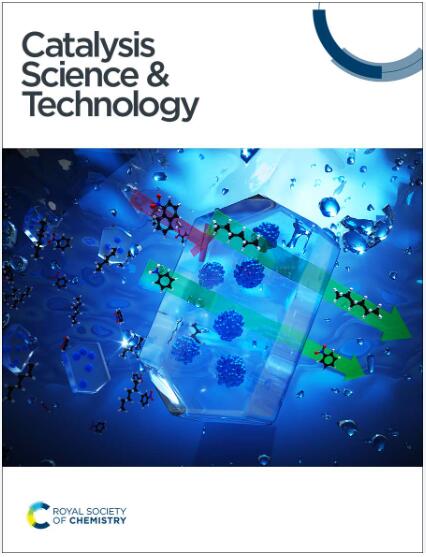沸石ZSM-5在甲醇制芳烃过程中水热取代Zn的催化意义
IF 4.4
3区 化学
Q2 CHEMISTRY, PHYSICAL
引用次数: 0
摘要
由未改性和载金属沸石ZSM-5催化的甲醇制芳烃(MTA)工艺为直接从可再生原料中生产液体芳烃提供了一种有前途的可持续方法。然而,传统的金属掺入方法往往导致金属被限制在沸石的表面或孔隙中。虽然这可以提高芳香的选择性,但它往往会对催化剂的寿命产生负面影响。为了解决这一挑战,本研究的重点是采用不同于传统金属浸渍方法的合成后水热取代工艺将Zn掺入ZSM-5的影响。我们的方法成功地将Zn直接集成到沸石框架中,增强了芳香选择性并延长了催化剂的寿命——这是一个违反直觉的结果,因为更高的选择性通常会加速催化剂的失活。我们采用了先进的表征技术,包括操作紫外-可见漫反射光谱和固态核磁共振,以更深入地了解双循环机制如何控制MTA过程。这些发现将为开发升级的沸石基催化系统铺平道路,用于芳烃生产中C1可再生原料的增值。本文章由计算机程序翻译,如有差异,请以英文原文为准。

The catalytic relevance of hydrothermally substituted Zn on the zeolite ZSM-5 during the methanol-to-aromatics process†
The methanol-to-aromatics (MTA) process, catalyzed by both unmodified and metal-loaded zeolite ZSM-5, offers a promising and sustainable approach for producing liquid aromatics directly from renewable feedstocks. However, traditional metal incorporation methods often result in metals being confined to the surface or pores of the zeolite. While this can enhance aromatic selectivity, it tends to negatively impact the catalyst's lifetime. To address this challenge, this study focuses on the impact of incorporating Zn into ZSM-5 using a post-synthetic hydrothermal substitution process, which differs from traditional metal impregnation methods. Our approach successfully integrates Zn directly into the zeolite framework, enhancing aromatic selectivity and extending catalyst lifetime—a counterintuitive result, as higher selectivity typically accelerates catalyst deactivation. We employed advanced characterization techniques, including operando UV-vis diffuse reflectance spectroscopy and solid-state NMR, to gain deeper insights into how the dual-cycle mechanism governs the MTA process. These findings will pave the way for developing upgraded zeolite-based catalytic systems for the valorization of C1 renewable feedstocks in aromatics production.
求助全文
通过发布文献求助,成功后即可免费获取论文全文。
去求助
来源期刊

Catalysis Science & Technology
CHEMISTRY, PHYSICAL-
CiteScore
8.70
自引率
6.00%
发文量
587
审稿时长
1.5 months
期刊介绍:
A multidisciplinary journal focusing on cutting edge research across all fundamental science and technological aspects of catalysis.
Editor-in-chief: Bert Weckhuysen
Impact factor: 5.0
Time to first decision (peer reviewed only): 31 days
 求助内容:
求助内容: 应助结果提醒方式:
应助结果提醒方式:


